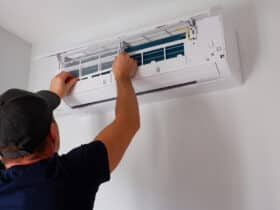According to recent data from the National Fire Protection Association, more than one-third of fires reported in the United States over the course of a year are structural. If a fire occurs in your home or business, you’ll want to begin the restoration process as soon as it’s safe to enter the building. But as you evaluate all the remediation work, you might notice an unusual mass of black spider webs across your walls and ceiling.
So what gives exactly? On top of the fire damage, is there now a spider infestation too? Before you panic, let us ease your mind: those are not spider webs. They’re tar and carbon particles released by the fire itself. Often called “soot tags,” these deposits become web-like formations as heat from a fire circulates into cooler spaces in the building. Here’s what to know about soot tags and how to clear them out—plus what you can do to minimize the risk of a structural fire occurring in the first place.
What Causes Soot Tags to Accumulate?
In the midst of a fire, the air circulation throughout your home or business will be relatively low. But once the smoke vaporizes and the indoor temperature lowers, any residue left behind will float into those cooler crevices. Next, the particulars will attach themselves together — usually in elevated places such as the corner where a wall meets the ceiling. This accumulated network of thin, fibrous threads is a soot tag.
Can Soot Tags Be Harmful to Your Health?
Airborne chemicals from the smoke, soot, or other toxins released in a fire could cause various health problems. Breathing in these particles can lead to respiratory irritation or compromised immune function, the Journal of Occupational and Environmental Hygiene warns. In extreme cases, prolonged contact can increase your risk of cancer or cardiovascular issues. That’s not to say a brief encounter with soot tags will cause immediate harm, but limit direct exposure to those formations as much as possible.
How Do You Clean and Remove Soot Tags?
After a fire, enlisting a professional remediation service to handle the clean-up and restoration process is always smart. But if those soot tags are relatively small and accessible to reach on your own, here are a few tips to effectively remove them:
- While cleaning, wear safety gear such as a face mask and eye shield to protect yourself from the soot residue.
- Create a dish soap and warm water solution, then use a soft sponge to scrub the soot tags away gently. Soot turns greasy when wet, so do not tackle it too abrasively, as this can cause permanent stains.
- Avoid cleaners with harsh chemicals—soot is corrosive and could react negatively to other compounds.
- If all else fails, use a melamine sponge to remove the soot. Also known as a Magic Eraser, it’s ideal for tough stains.
Once you have taken these basic actions, it’s time to call in the experts. A team of remediation technicians will thoroughly inspect the fire damage, then clean your entire home or business to eliminate all traces of residue. This will ensure the environment is safe to occupy once again and restore your building to its pre-fire condition. In many cases, a remediation service can also help with filing insurance claims.
How Can You Prevent a Fire, to Begin With?
According to the Journal of Injury and Violence Research, at least 75 percent of structural fires are preventable. So before worrying about what to do in the aftermath, which safety measures can you take to reduce the threat of fire altogether? As with any natural disaster, fires can be unpredictable — but here’s how to mitigate your risk:
- Remove any pine needles, tree branches, leaves, or other debris from your roof and gutters consistently.
- Store gasoline, propane, or other flammable substances in an airtight safety container at least 10 feet from the building.
- Trim the landscape to remove decaying branches and vegetation within 10 feet of a chimney or other exterior flue opening.
- Soak stove or fireplace ashes in a metal bucket of water, then dispose of the remains away from combustible materials.
- Disentangle all electrical cords. Do not use cords with fraying or short circuits. Unplug cords from outlets when not in use.
- Never place an electrical device within 5 feet of a water source or a wet surface. This can ignite a spark or cause electrocution.
- Keep candles, incense burners, or open flames away from combustible surfaces. Snuff them out before leaving the room.
- Turn off your stovetop, oven, and other cooking appliances when not in use. Nearly 50 percent of home fires start in the kitchen.
- Store batteries in a low-moisture area at room temperature, away from metal and other objects that could ignite a flame.
Soot Tags and Other Fire Damage Are Avoidable
On average, fires are reported every 23 seconds here in the United States. Once all that smoke clears, the damage can be extensive — but it does not have to reach this point. With careful planning, you can lower the risk of structural fires in the first place. So take steps now to avoid those pesky soot tags and other problems in the aftermath.
















